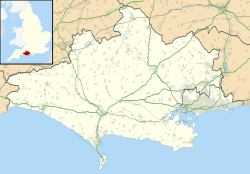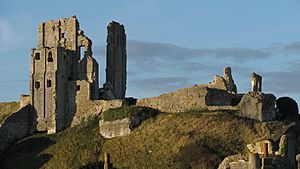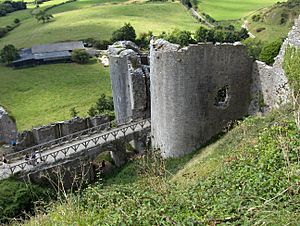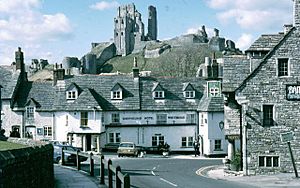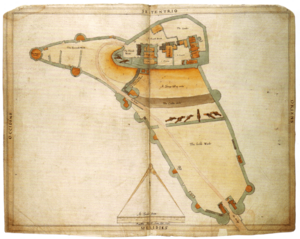Corfe Castle facts for kids
Quick facts for kids Corfe Castle |
|
|---|---|
| Corfe Castle, Dorset, United Kingdom | |

Ruins of Corfe Castle from the outer bailey
|
|
| Coordinates | 50°38′24″N 2°03′29″W / 50.640°N 2.058°W |
| Type | Castle |
| Site information | |
| Owner | National Trust |
| Open to the public |
Yes |
| Condition | Ruined |
| Site history | |
| Demolished | 1645 (partially) |
| Battles/wars | English Civil War |
Corfe Castle is an old fortress located above the village of the same name. It sits on the Isle of Purbeck in Dorset, England. William the Conqueror built this castle in the 11th century. It guards a natural gap in the Purbeck Hills, which was an important route between Wareham and Swanage.
Corfe Castle was one of the first castles in England to be built partly with stone. Most castles at that time were made of earth and wood. Over the years, especially in the 12th and 13th centuries, the castle was changed and made stronger.
In 1572, Elizabeth I sold Corfe Castle to Sir Christopher Hatton. Later, Sir John Bankes bought it in 1635. He owned it during the English Civil War. While Sir John was away, his wife, Lady Mary Bankes, bravely defended the castle. She faced attacks from Parliamentarian forces twice.
The first attack in 1643 failed. But by 1645, Corfe was one of the last places still held by the Royalists in southern England. It was captured after another siege. In March 1645, Parliament ordered the castle to be destroyed. Today, Corfe Castle is owned by the National Trust. It is open to visitors and is a protected historic site.
Contents
History of Corfe Castle

A Royal Castle
Corfe Castle was built on a steep hill. This hill is in a gap formed by two streams cutting through a line of chalk hills. The name Corfe comes from an old English word meaning 'a cutting', which describes this gap. Before the castle, Anglo-Saxon nobles lived here. Queen Ælfthryth, wife of Edgar had a hall on this spot. It's believed that the young King Edward the Martyr visited her here in 978 and was killed at the castle.
A castle was started at Corfe soon after the Normans took over England in 1066. William the Conqueror liked to hunt in the nearby Isle of Purbeck. Between 1066 and 1087, William built 36 castles in England. Corfe Castle, on its hilltop, looks like a classic medieval castle. But most castles were actually built in valleys, often near important river crossings.
Corfe was special because it was partly built from stone in the 11th century. This shows it was very important. A stone wall was built around the hilltop, making an inner area. There were also two other areas, or baileys, protected by wooden fences. Most castles at this time were made of earth and wood. It wasn't until the 12th century that many were rebuilt in stone. The Domesday Book of 1086 mentions a castle in Dorset. It's thought to be Corfe, not the wooden castle at Wareham.
In the early 12th century, King Henry I started building a stone keep (the main tower) at Corfe. This work began around 1096 and finished by 1105. The castle was built using Purbeck limestone, which was quarried a few miles away. The chalk of the hill itself was not strong enough for building. By the time of King Stephen (1135–1154), Corfe Castle was a very strong fortress. It had a stone keep and an inner stone enclosure. In 1139, during a civil war, Corfe successfully defended itself against King Stephen's attack.
During the reigns of King John and King Henry III, many new towers, halls, and walls were added. Both kings held Eleanor, a royal prisoner, at Corfe until 1222. King John also held Scottish hostages there. The Gloriette, a grand building in the inner area, was likely built during King John's time. Records show that a lot of money was spent on strengthening the castle's defenses during these periods. This often happened when there was political trouble.
Castles were also used for storage. In 1224, King Henry III sent to Corfe for 15,000 crossbow bolts. These were needed for a siege at Bedford Castle. Henry III also spent a lot of money on the castle, especially on the keep. While construction was happening, a camp for workers grew outside the castle. This camp eventually became the village of Corfe. In 1244, Henry III ordered Corfe's keep to be whitewashed, just like the White Tower in London.
In December 1460, during the Wars of the Roses, an army marched from Corfe Castle. They were heading for the Battle of Wakefield.
After the Medieval Period
Corfe Castle remained a royal fortress until 1572. That's when Queen Elizabeth I sold it to Sir Christopher Hatton, her Lord Chancellor. Ralph Treswell, Hatton's manager, drew plans of the castle. These are the oldest surviving maps of the castle.
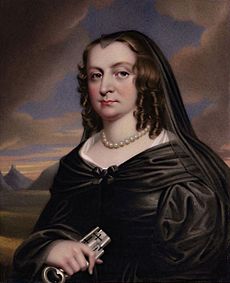
Sir John Bankes, who worked for King Charles I, bought the castle in 1635. The English Civil War began in 1642. By 1643, most of Dorset was controlled by Parliament. While Sir John was away with the king, his wife, Lady Mary Bankes, stayed at Corfe Castle with their children. She defended it for the king. Parliament's forces tried to sneak into the castle, but they failed. They also tried to stop supplies from reaching the castle. Lady Bankes, with only five defenders at first, managed to get food and increase her garrison to 80 people. The Parliamentarians, with 500 to 600 soldiers, began a long siege. It lasted six weeks until Royalist forces came to help Lady Bankes.

By 1645, Parliament was winning the war. Corfe Castle was one of the last places still held by the Royalists in southern England. So, it was attacked again by Colonel Bingham's forces. One of the castle's own officers, Colonel Pitman, secretly helped Bingham. Pitman pretended to bring Royalist reinforcements, but they were Parliamentarian soldiers in disguise. Once inside, they waited. When the outside forces attacked, the defenders were attacked from both sides. Corfe Castle was captured. Lady Bankes and her soldiers were allowed to leave. In March of that year, Parliament voted to destroy the castle. This is why it looks ruined today.
Many castles were destroyed after the war. Their strong walls made them hard to completely demolish. Corfe Castle's stones were then used by villagers to build their own homes. After the monarchy was restored in 1660, the Bankes family got their properties back. But instead of rebuilding Corfe Castle, they built a new house at Kingston Lacy.
Archaeological digs at Corfe Castle began in 1883. More work was done in the 1950s and again from 1986 to 1997. Corfe Castle is thought to be the inspiration for Enid Blyton's Kirrin Island in The Famous Five books. It was also used as a filming location for Five on a Treasure Island (1957) and Bedknobs and Broomsticks (1971).
Corfe Castle Today
When Ralph Bankes passed away in 1981, he left his entire estate to the National Trust. This included Corfe Castle, much of the village, and the family home at Kingston Lacy.
In 2006, the main tower (keep) became unsafe for visitors. The National Trust started a big project to fix and preserve the castle. The keep reopened in 2008, and the work finished the next year. During this restoration, a special "appearance" door was found in the keep. This door was designed for King Henry I. The National Trust believes this shows Corfe Castle was one of the most important castles in England at that time.
Corfe Castle is a Grade I listed building. This means it's a very important historic structure. It's also a Scheduled Monument, which protects it from unauthorized changes. The old earthworks nearby, called "The Rings," are also protected. They are thought to be the remains of a castle built during a siege in the 12th century. Corfe Castle is a very popular place to visit, with hundreds of thousands of visitors each year.
Castle Layout
Corfe Castle is shaped roughly like a triangle. It is divided into three main parts, called enclosures or wards.
The inner ward was built in the 11th century. It held the castle's main tower, or keep. This tower was partly built into the wall around the inner area. It's believed the keep was built between 1100 and 1130, during King Henry I's rule. Attached to the keep is a special entrance building with stairs and a guardroom. To the east of the keep are the ruins of a building called the Gloriette, likely built by King John.
The remains of the west bailey, a stone wall with three towers, were built between 1202 and 1204. It looks similar to the bailey of Château Gaillard in France, which was built for King Richard I.
See also
 In Spanish: Castillo Corfe para niños
In Spanish: Castillo Corfe para niños


